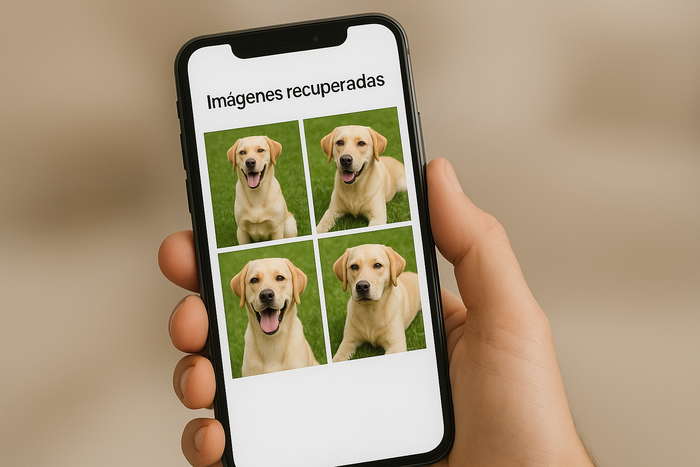Get practical tips, key benefits, and learn how to prevent future data loss.

GPT
If you need to recover deleted photos from your phone, memory card, or even your computer, DiskDigger might be exactly the solution you’re looking for.
Losing important images — whether from special moments, professional work, or unique records — is a distressing situation, and increasingly common in our digital lives. Relief comes when we realize that not everything is lost.
DiskDigger is a powerful and accessible app developed to recover deleted files quickly and easily. With it, you can scan your device’s memory for photos, videos, and even documents that were deleted — even days or weeks ago.
In this article, you’ll learn how DiskDigger works, what types of files it can restore, when it’s worth using, and how to increase your chances of successfully recovering deleted content. After all, in a world where every image tells a story, having a reliable tool on your side makes all the difference.
What is DiskDigger?
DiskDigger is an app designed for those who need to recover deleted files, especially photos, videos, and documents.
It works on both Android smartphones and computers, and its main strength is its ease of use: even those with little tech knowledge can operate it with just a few taps or clicks.
Whether due to accidental deletion, system failure, unexpected formatting, or memory card issues, DiskDigger jumps into action to scan your device’s storage and find files that can still be recovered.
Why do users love DiskDigger?
The answer lies in a powerful combination of simplicity, efficiency, and accessibility.
The app pairs an intuitive interface with solid performance, allowing even beginners to recover files without complications.
It also offers versions that range from a basic one — ideal for quick photo recovery — to a more advanced version capable of restoring other file types and performing deeper system scans.
Another plus is its lightweight nature: DiskDigger doesn’t require much from your device, making it a great choice even for simpler phones or computers with limited space.
What can you recover with DiskDigger?
Many people believe only photos can be recovered. But the truth is, the app goes beyond that. With DiskDigger, you can attempt to recover:
- Photos in various formats (JPEG, PNG, etc.)
- Videos
- Text documents
- PDF files
- Spreadsheets
- Audio files
- And much more (depending on the version and scan type)
Of course, the more recent the deletion and the less the device has been used since, the higher the chances of recovery. That’s because deleted data is marked as “free space” and may be overwritten at any time.
How does DiskDigger work?
The magic lies in how it scans the storage sectors. There are two main types of scanning:
1. Quick scan (shallow)
Ideal for recently deleted files. It looks for data that’s still well-preserved and usually recovers them with intact names and structure.
2. Deep scan
This option takes more time but is also more powerful. The app scans the entire memory, identifying fragmented files or older data. It might not preserve file names or folders, but this is often where the recovery miracles happen.
On Android, if the phone has root access, DiskDigger gains more scanning power, reaching system areas that are normally inaccessible. But even without root, it can still recover recent files — especially photos.
How to use DiskDigger in practice
Using DiskDigger is like following a simple recipe. Here’s a basic step-by-step:
- Download the app or program to your device.
- Open the app and allow the requested permissions.
- Choose the scan type: shallow (faster) or deep (more effective).
- Wait for the analysis and view the found files.
- Select the files you want to recover and choose where to save them — local storage, a flash drive, or even the cloud.
Pro tip: Avoid saving recovered files in the same location they were deleted from. This prevents overwriting and improves the chances of recovering other files.
Is DiskDigger really safe?
Yes, and that’s one of the main reasons for its success.
The app doesn’t require registration, doesn’t collect sensitive user data, and works directly, without exaggerated promises.
It’s always important to download the official version, either from app stores or the developer’s website. Modified versions can pose security risks and harm your device.
Moreover, DiskDigger doesn’t “trick” users. It clearly shows what can be recovered, the condition of each file, and the real chances of success.
Limitations you should know
Despite being highly effective, DiskDigger isn’t magical. There are a few limitations to keep in mind:
- If the device has been heavily used after deletion, recovery chances decrease.
- Without root, the app has more restricted access on Android.
- Some recovered files may be corrupted or incomplete.
These aren’t flaws in the app, but common technical limitations of any data recovery software. That’s why the sooner you act, the better your chances of success.
Are there alternatives? Yes, but…
There are other apps and software on the market with similar goals.
Some are more robust or technical, but not all are as simple and accessible as DiskDigger.
If you’re looking for a practical, fast, and user-friendly tool, it remains one of the best options.
For those needing more advanced or business-level solutions, there are more complex software tools — but they also come with higher costs and learning curves.
How to prevent future file loss
The best recovery is still prevention. Here are some valuable tips to avoid facing this issue again:
- Enable automatic backups using Google Photos, OneDrive, or iCloud.
- Keep important files stored in two or more locations (e.g., external drive + cloud).
- Avoid installing apps from unreliable sources.
- Use cleaning tools carefully and review files before deleting.
- Perform regular maintenance on your devices to prevent unexpected failures.
These simple habits can save you time, stress, and even money.
Is DiskDigger worth trying?
If you’ve made it this far, chances are you’re dealing with — or have dealt with — the frustration of losing important files.
In that case, the answer is simple: DiskDigger is absolutely worth trying.
It’s lightweight, fast, intuitive, and has already helped thousands of people recover photos, videos, and documents once thought lost forever. Best of all, you can start for free with the basic version.
Even if you don’t need it right now, keeping it installed for emergencies is a smart move. After all, you never know when the unexpected might happen.
Conclusion: More than files — reclaim your peace of mind
Losing important files is frustrating, but knowing a tool like DiskDigger exists makes everything easier to deal with.
Thanks to its simplicity and efficiency, it’s become the ideal ally for anyone who needs to recover deleted photos quickly and safely, whether due to accident or device failure.
Still, just as important as recovery is prevention. Keeping your phone organized, with enough free space and no unnecessary clutter, is essential for smooth performance and avoiding accidental loss.
Want to learn how to clean your phone’s memory effectively and safely?
In the next article, we’ll guide you step-by-step on how to free up space on your device without deleting what really matters. Don’t miss it!
Apps to clean memory
Is your phone slow or running out of space? Learn how to clean up your memory and make it feel brand new!
